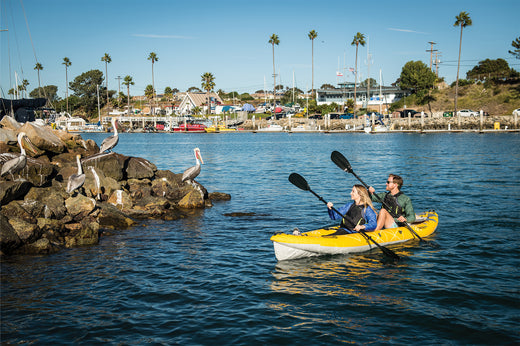Complete Guide to Tandem Kayaking: How to Paddle a Tandem Kayak
September 02, 2024

Solo kayak trips can be exhilarating, but sharing the experience with a partner in a tandem kayak offers unique rewards. Not only is buying a double kayak more cost-effective, but it’s also a fantastic way to introduce a novice to the joys of kayaking. With the guidance of a more experienced paddler, a beginner can quickly learn the ropes, making the journey more fun and comfortable.

What Is Tandem Kayaking?
A tandem kayak is simply a kayak with two seats instead of one. Two-person kayaks allow both kayakers to paddle simultaneously or one paddler to take a break while the other continues paddling.
Tandem kayaks are heavier and sturdier than single kayaks, often making them better suited for activities like fishing or long trips. They typically feature a broader beam for increased stability and have ample storage space for gear.
Tandem kayaking is all about teamwork, communication, and coordination. Perfecting tandem kayak paddling techniques and maintaining a steady pace together are essential for a successful, enjoyable outing.
Sit-on-Top vs. Sit-Inside Tandem Kayaks
Tandem kayaks come in two main kayak types: sit-on-top and sit-inside. Sit-on-top kayaks are easier to get in and out of, making them perfect for recreational use in warmer climates. Sit-inside kayaks offer more protection from the elements, making them better suited for touring or colder conditions. Understanding these differences can help you choose the best tandem kayak.
Paddling Techniques for Tandem Kayaking
Mastering tandem paddling techniques is critical for a smooth kayaking adventure. It’s essential to paddle in unison to move efficiently and avoid clashing paddles. The front paddler sets the pace, while the rear paddler follows this rhythm and controls the steering.
For effective steering, the rear paddler can apply more vigorous strokes on one side to turn the kayak or use a combination of forward and reverse strokes on opposite sides for sharper turns.
Starting with the more experienced paddler in the back usually allows for better control and coordination. The rear paddler, who typically has a better view of the water ahead, should communicate any course corrections or changes in pace to the front paddler. This teamwork helps prevent the common zigzagging issue and ensures a smoother ride.
Clear communication between paddlers is vital; good coordination also extends to taking breaks. Both paddlers should stop simultaneously to maintain balance and prevent tipping.
Solo Paddling in a Tandem Kayak
You’ll typically remove one seat and move the other to the middle to paddle a tandem kayak solo. This setup distributes your weight evenly throughout the kayak, allowing for effective solo paddling. Tandem kayaks are a flexible option, even on your own.

Benefits of Tandem Kayaking
Tandem kayaking is a fantastic way to bond with family and friends, introducing them to kayaking in a safe and fun environment. The increased stability of tandem kayaks makes them perfect for beginners, and the shared experience can foster deeper connections through teamwork and communication. Here are some of the unique benefits of tandem kayaking:
- It’s an excellent way to introduce beginners to the sport, with the experienced paddler taking on most of the steering and paddling responsibilities.
- This setup is also ideal for families, allowing children, elderly individuals, or even pets to join the adventure without requiring them to paddle.
- Tandem kayaks are generally more stable than single kayaks, making them less likely to capsize, which is reassuring for beginners.
- The added stability also makes these kayaks safer, particularly in choppy waters or when carrying heavier loads.
- Tandem kayaking is an opportunity to build stronger bonds, improve communication, and navigate the natural world with your friend or partner.
Whether you’re exploring serene lakes, tackling river rapids, or enjoying coastal scenery, tandem kayaking offers an exciting experience that will draw you back time and again.
Stability and Safety Tips
Tandem kayaks are designed to be stable, but safety should always be a priority. Always use a personal flotation device (PFD) or life jacket. In the event of a capsize, the wide beam of most tandem kayaks makes it easier to re-enter from the water. Paddlers can re-enter one at a time for sit-on-top kayaks while the other stabilizes the kayak.
Choosing the Right Tandem Kayak
When selecting a tandem kayak, consider the weight limit, seat comfort, storage space, and footrest adjustment. If you’re planning long trips, the extra storage space in a tandem kayak will be invaluable for carrying your gear and supplies.
Specific models offer versatility, with multiple configurations for solo or tandem paddling. An inflatable kayak is easy to transport and set up, making it an excellent choice for spontaneous adventures.
High stability and a self-draining hull are also important factors, particularly for beginners or those seeking a low-maintenance option. You'll also need to ensure that you choose the best kayaking paddles for you & your partner.
Frequently Asked Questions
What is tandem kayaking?
Tandem kayaking involves two paddlers in the same kayak, working in unison to navigate the waters. It can be an exciting, shared adventure that enhances camaraderie and coordination.
What type of tandem kayaking destination is suitable for beginners?
Lakes and reservoirs are ideal for novice kayakers due to their calm conditions. These locations provide serene surroundings for tranquil paddling and leisurely scenic viewing.
Is coastal tandem kayaking suitable for all skill levels?
Coastal areas offer a good mix of calm and adventure, making them suitable for various skill levels. Kayakers can practice communication skills and enjoy wildlife encounters while navigating the coastal waters.
What is river tandem kayaking like?
River tandem kayaking offers dynamic experiences with its downstream flows. However, it requires navigating through rapids. Therefore, coordination and skillful paddling are vital for a safe and enjoyable adventure.
What are the benefits and challenges of tandem kayaking?
Shared adventures in tandem kayaking offer several unique benefits, including strengthening bonds, cooperative learning, and shared experiences. However, challenges can arise regarding coordinating your pace and rhythm with the other paddler, especially in rough waters.

